WORLD CLASS COACHING
Pep Guardiola Attacking
By Luca Bertolini
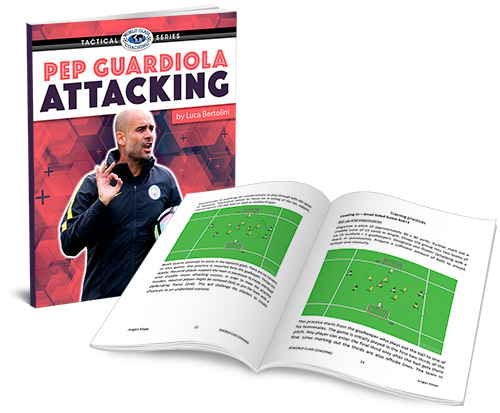
Table of Contents
PART FOUR
Counter-Attacking
Set Plays
Counter-Attacks
Manchester City scored 28 times (18% of all goals) after a counter attack during this last 2017/2018 season. This following scheme sums up the average percentages of each match; 3% of counter attacks ended with a goal. We must obviously think that many of what could be thought as missed counter attacks, they don't have to be considered lost balls, but they have been converted into possession phases or positional attacks, due to spaces coverage by the opposition.
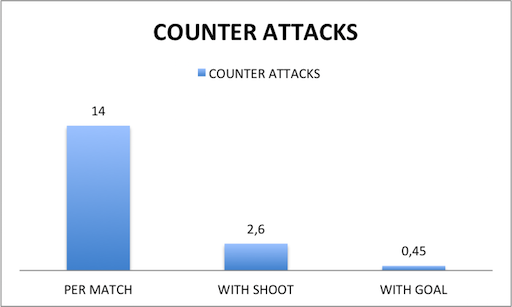
Guardiola has been always seen as an idealist of football, but, eventually, he is much more flexible than everyone thought. When he moved to Bayern Munich, he applied much of the possession and pressing tactics of Barcelona, but taking advantage of the center forward at his disposal, Robert Lewandowski, who played as classic number 9. He also used the inverted wingers, Arjen Robben and Franck Ribery, as counter attacking players.
The most important evolution of Guardiola's style of play from Barcelona years to Manchester City seasons is the idea to counter attack even if the players are involved in an outnumbered situation after the recovery of the possession; nothing ever seen during Barcelona "tiki-taka" winning years (2008-2012).
The speed of City's counter-attacks has not only brought goals, but it has made the high press defending tactic riskier for the opponents; this is one of the main differences from the first 2016/2017 season. On the other side, to defend back and deep invited Man City to attack again and again as we have already analyzed.
Pep Guardiola has transformed his team into one of the best counter-attacking teams of the Premier League.
City players have been always the leaders of the possession average and they have been magnificent in pushing down the opposition and in exploiting the spaces behind the opposition defense, throughout the whole season; but they have been so good at counter attacking also, every time there was enough space.
De Bruyne is the most "counter-attacking player" among the advanced midfielders of Man City and he is the main reason why Guardiola decided to improve this team tactic, making the squad one of the most dangerous team on the counter in the League. The physical stamina during the pressure phases and in the 1 v 1 duels against the opponents makes De Bruyne able to recover many balls inside the attacking half and his speed of play and vision of the game inside open spaces allow Man City counter-attacking even if and when definitely outnumbered.
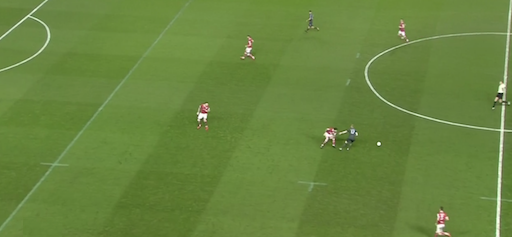
A general 4 v 2 duel is very clear in this picture, but the Bruyne is able to avoid the pressure of the defender and Aguero is in positional advantage against the defender, who is not running back properly, as he can see neither the possession opponent, nor the nearest forward, who is running toward the goal.
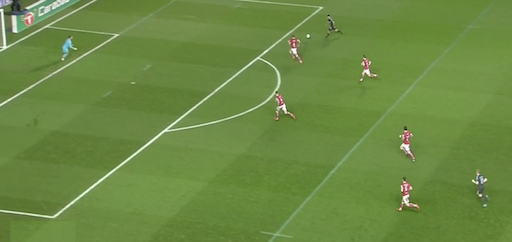
When the defender can turn, Aguero has already received and controlled the pass with the first touch...
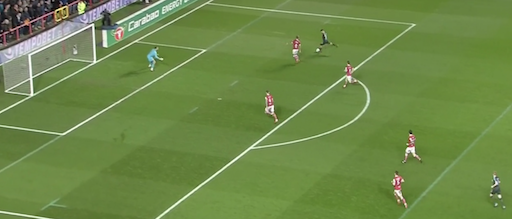
...and he can finish easily with the right timing, shooting in the space between the defender and the goalkeeper and toward the second pole.
The following sequence is very interesting because it shows clearly the second main task of the wingers inside the tactical plan of Guardiola's Man City. Sanè and Sterling must be usually placed wide along the sidelines to open the opposition defense line or create a strong side; this during the possession and positional attacking phases when the width of the space is intended to be the width of the field.
When City is counter attacking, the wingers run inside the field, they stay positioned at the back of who is, for them, the last defender, and they attack the goal; in these kind of moves the concept of width is different, as it is intended to be the needed space to gain positional advantage and to receive, being able to attack the goal with an oriented one touch control.
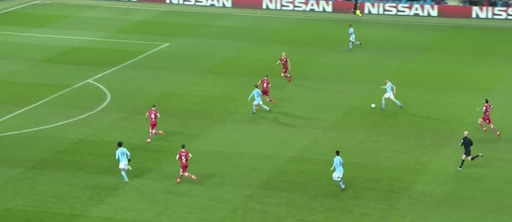
De Bruyne is carrying the ball here, and both the wingers and the center forwards are attacking the depth and their direct marker at the back.
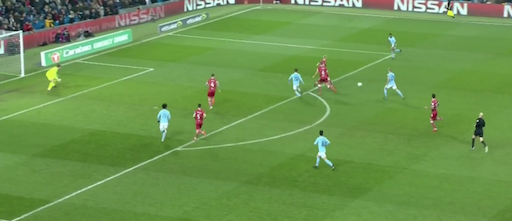
Sterling attacks the depth inside the penalty area to receive...
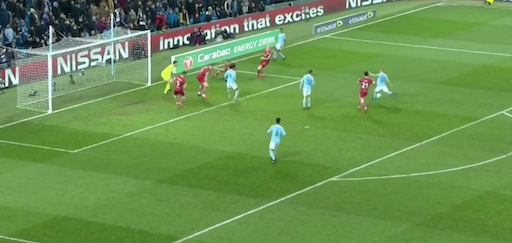
...and the opposite winger Sanè attacks the goal on the first pole, inviting the opposition defense block back deep, and freeing the support player to finish (De Bruyne).
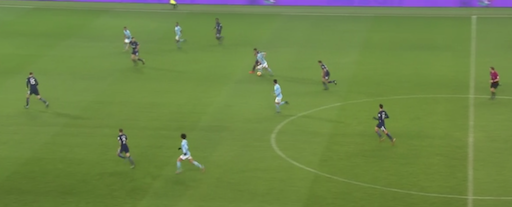
Here again, De Bruyne wins the ball thanks to a pressure phase...
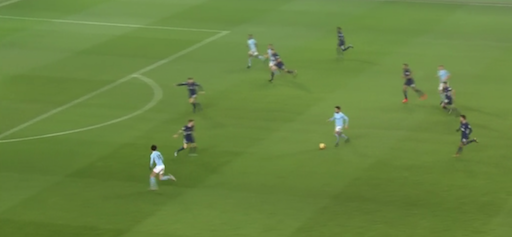
...Gundongan is in possession then and he carries the ball toward the opposition goal.
Both the wingers and the center forward Aguero attack their direct opponents at the back and they place themselves in a positional advantage.
The defender near Sanè is anyway wrongly positioned with his body, as he is in front of the ball carrier and he doesn't follow the winger on his run.
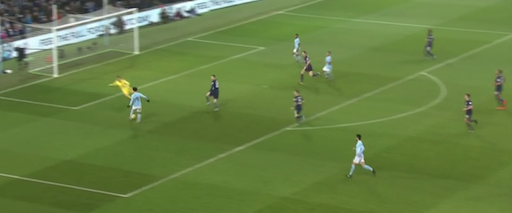
Sanè is then able to receive free, attacking the first pole and anticipating the goalkeeper who tries to run out...
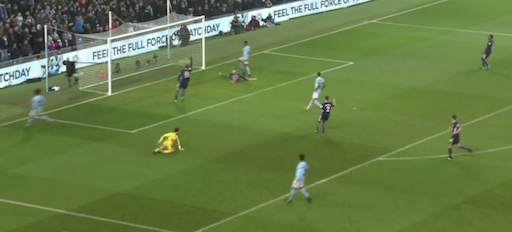
...and Sterling can finish on the opposite second pole.
This is another sequence that shows a different concept of counter attacks, when the ball is recovered along the flanks. De Bruyne has recovered the possession again and he is carrying the ball along the right flank; the winger (Sterling) runs inside to create space for him and for a third teammate, who could run from the back (Walker).
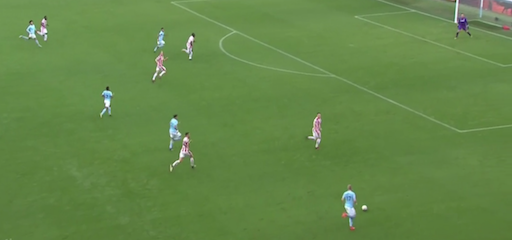
The opposite winger (Sanè) and the center forward (Gabriel Jesus) attack the penalty area.
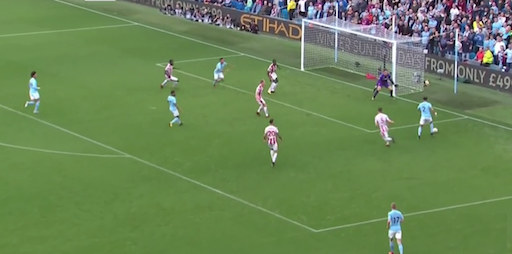
Walker can receive the ball deep inside the penalty area and behind his direct opponent...
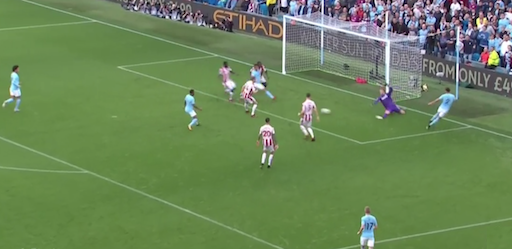
...and Gabriel Jesus can score anticipating his direct marker on the first pole. Both the wingers could be able to win a rebound inside the penalty area.
City seemed to be so dangerous when in possession, as well as when their opponents had the ball. If the opposition possession phase could be stopped on the edge of the own box and City could counter attack to the other end, the other team could hardly have a chance to regroup.
Guardiola and City have been able to mix the concepts of possession and counterattack; the third goal that was scored in the winning away match against Arsenal, played last March the 3rd, 2018, is very explicative:
1) Creation of a strong side/area, management of the opposition pressure, keeping the ball possession inside tight spaces (Kompany and Walker invite the opposition pressure).
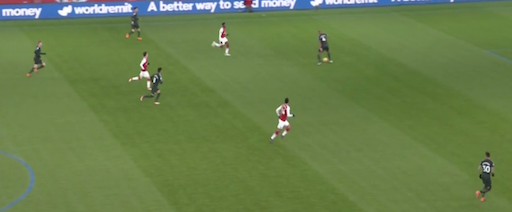
2) One forward or a center advanced midfielder drops back to receive and to bring at least one opposition defender out of the block; the goal is to create a space to exploit behind him or behind the whole defense. Aguero is dropping back here to play with David Silva, who is placed in a support position and then to Bernardo Silva, who is positioned wide on the right, directly or through a third man.
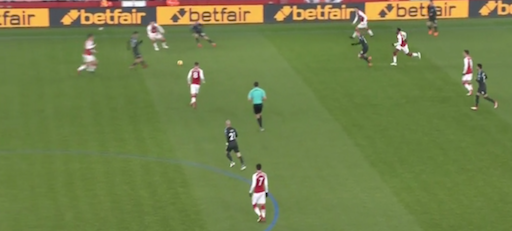
3) This would be the recurrent combination: a back pass, followed by a forward pass in the space, on the run of the center forward or of the wingers. If the pressure against the dropping back player or against the receiver of the back pass is successful, the possession phase inside the strong side is resumed to move the opponents again. It's interesting to notice that Aguero stays positioned in between the midfield and defense lines; this will be a key factor to dribble the ball forward on the field and to finish.
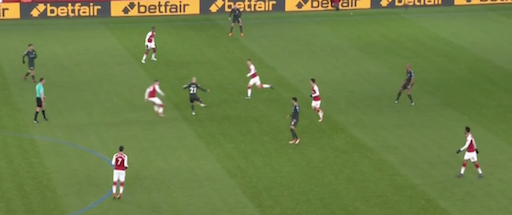
4) David Silva is in possession again and he is playing inside a square that is shaped by four Arsenal players, together with Walker and Bernardo Silva; but the Arsenal defense shape is not right, because the line has been moved again and again by the possession phase of Man City. David Silva is able to receive and he seems to be under pressure; but the pressure direction is not toward the opposition goal and he is able to orientate the ball control and to attack the available space, before another opponent can press him. Arsenal midfield line leaves space in the middle third to combine and play forward.
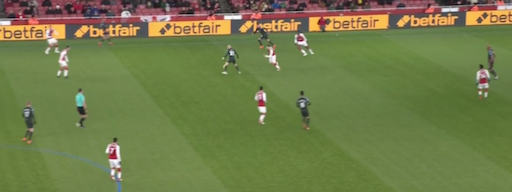
5) The center forward is now able to receive and, moreover, he can receive in positional advantage against his direct marker. Aguero can exploit the space in the middle third to receive and then he can exploit the forward spaces to dribble; the direct marker is not positioned on this side of the forward body and toward the goal. Aguero has now space to exploit and the nearest second defender who can cross his dribbling line and close the space is too far to be effective.
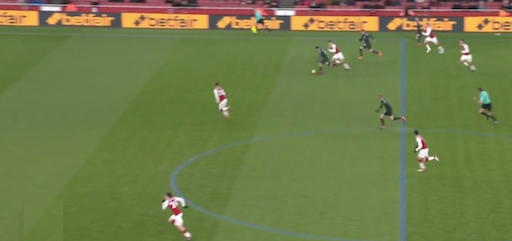
The same space inside the attacking half is now created, as if the possession was just recovered, after a possession phase of the opposition; this could be a classic counter attack situation.
6) Bernardo Silva along the same flank and Sanè, who is cutting inside from the opposite one, support the move and take active part to the finishing stage
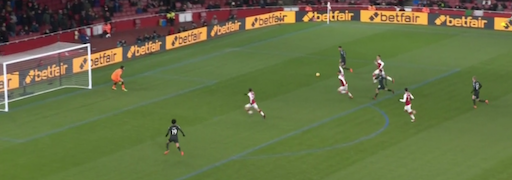
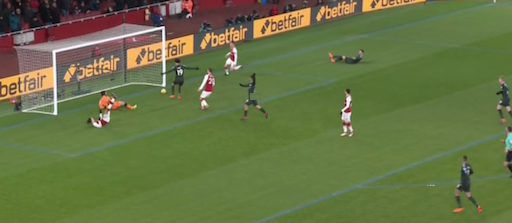
Guardiola's method is simple: spread the play all over the pitch and create overloads, leaving defenders with too many players to deal with and too much space to be able to stop them.
Even when Man City players are under pressure, like Vincent Kompany, Kyle Walker and David Silva at the beginning of the move, we have just analyzed, and they are forced to combine with risky touches, playing some passes toward teammates in difficult body positions to control the ball, everybody follow their principles of play.
The amazing point of this move is the creation of what could be a counter-attacking move through a prior possession phase and not through the recovery of the ball, after a pressure phase against the opposition.
Set Pieces
"I understood English football the day I saw one game; I was at home, Swansea vs. Crystal Palace were playing. Nine goals, eight from set pieces. You have to control that, and we are unable right now to control that. Eight goals from set pieces, corners, free kicks, throw-ins. That is English football and I have to adapt because never before I have lived that.”
Pep Guardiola, December 2016
"Now we have to improve in the set pieces because West Ham, United, all the teams...Tottenham…all the teams are stronger and taller and higher than us, that is why we have to spend more time on that.” Pep Guardiola, December 2017
This is another aspect of the evolution of Pep Guardiola; set pieces for his Barcelona were almost a way to resume the game and the possession phases. Set pieces were properly intended as a defense phase against the long balls of the opposition. At Bayern Munich, corner kicks and free kick started to be played toward the box, because of good skilled heading players like Lewandowski, Müller, Martinez, Dante, Alaba and others. Again Man City seems to be a mix of the early Guardiola and his evolution at Bayern Munich. As he stated many times, English football is a game even made of long balls, free kicks, corner kicks, and after the first season he realized his team was asked to become dominant also in these phases, to win the title.
Here are some data about 2017/2018 season and even if Man City squad is not strong and tall like many other teams of the Premier League, two recurrent tactics to exploit the attacking set pieces are very clear and recognizable:
1) Quick passing combinations to shoot on goal from corner kicks
2) Attack of the first pole to anticipate the opponents, reducing the physical gap, if the ball is played high
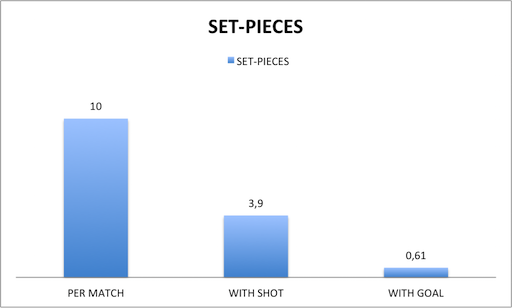
De Bruyne and Gundogan are the kickers of nearly all the free kicks and corner kicks, whatever is the side.
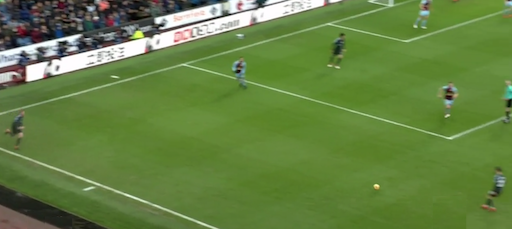
This is a first example of a three men combination, exploiting the spaces out of the penalty area, when the opposition overloads it.
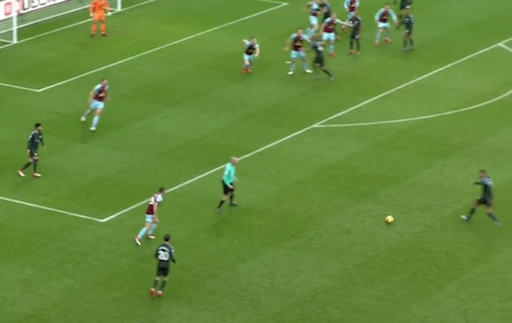
Bernardo Silva can easily control the pass from De Bruyne, without pressure and he can play to Danilo, toward the center...
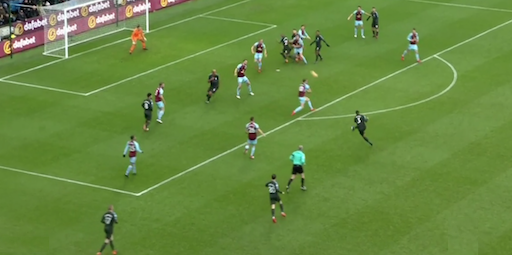
...and Danilo can shoot without pressure too, as all the opponents are inside the penalty area, to create numerical advantage there, but being too much on late to run out and press the receiver.
This another example of passing combination where Sanè can receive freely along the end line, with no protection of the first pole at the beginning, taking advantage of the zonal marking of the opposition inside the penalty area.
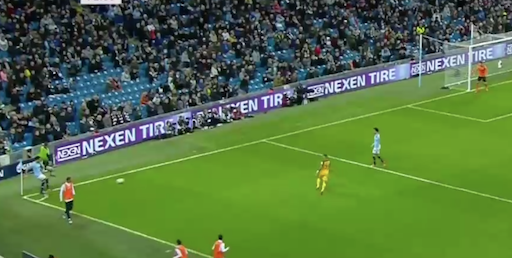
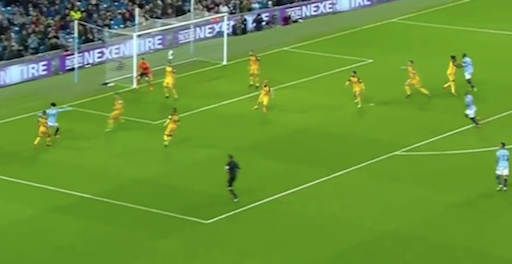
The 1-3-4 zonal defense formation of the opposition is clear, but they are not marking anyone while the ball is moving, except an outer 1 v 1 duel. The late pressure against Sanè can't stop him from passing back, crossing the run of Fernandinho...
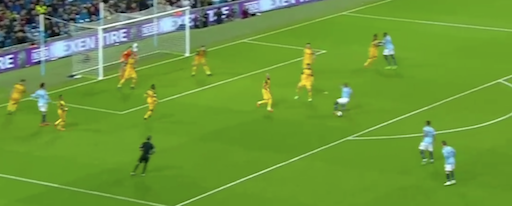
...who can shoot on goal freely against on late defenders.
In this sequence, it's clear how Basel team is trying to avoid short passing combinations from the corner kick (4 players are placed on the side of the corner kick).
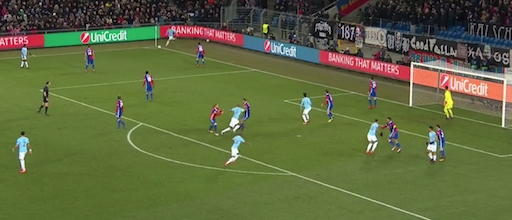
But they leave 1 v 1 duels inside the box, with one defender who is saving the first pole.
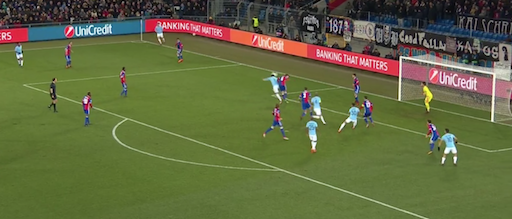
Gundogan can score anticipating his direct marker, as the direction of the pass overcomes the nearest block of 4 players and it's too far from the opponent on the first pole; the 1 v 1 duel is then well exploited.
This is an explicative free kick situation. The defenders are placed along the same line of two-man wall in front of De Bruyne.

De Bruyne kicks and Man City is outnumbered inside the box, with only four players who could exploit the pass.
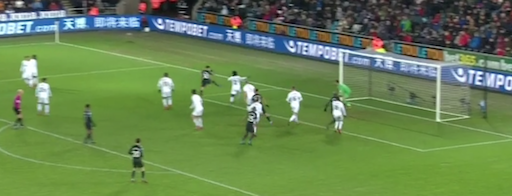
But the idea is to look for the first pole, that is not saved, and to anticipate the direct marker; this way the numerical advantage of the opposition is totally nullified.
Here is the same prior situation...
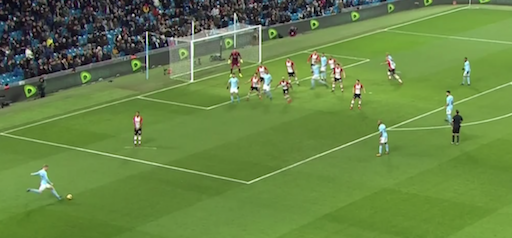
...nullify the numerical advantage of the opposition, attacking the first pole when it's not properly saved.
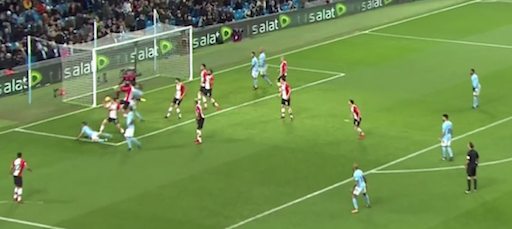
The late defense of the zone is just a consequence of timing.
This is a last similar situation, but farther from the box; the opposition defense line is placed on the edge of the penalty box.
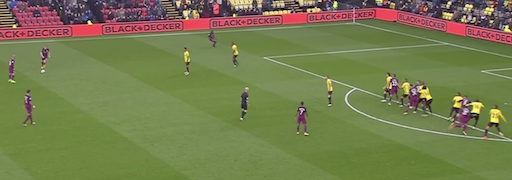
De Bruyne kicks again toward the first pole space and not toward the center of the group, where winning a duels is easier...
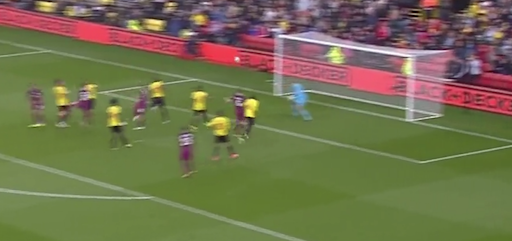
...and Gabriel Jesus can score anticipating the direct marker and taking advantage of the decision of the goalkeeper, who has not come out to catch the ball.


